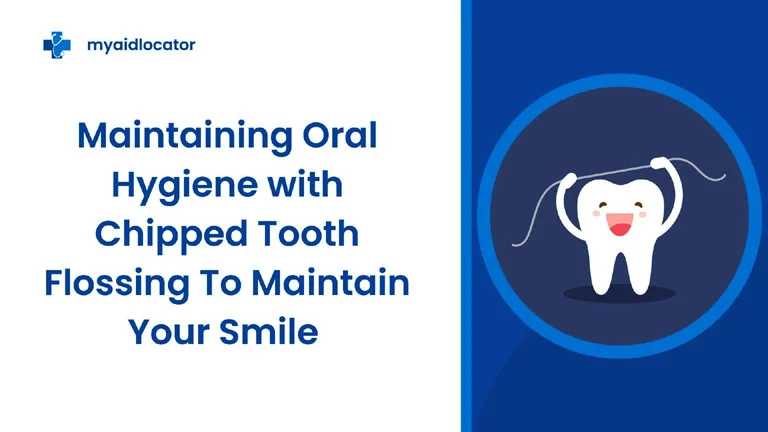Chipped tooth flossing can be done or not is a common question for many people. It is possible and can be harmless and effective if done properly and gently. You can efficiently clean the areas between your teeth while avoiding further harm by being gentle.
A chipped tooth can be both aesthetically concerning and painful. Flossing around a chipped tooth requires special attention to prevent further damage or discomfort. To prevent further damage or stress, flossing with a chipped tooth requires extra care and attention.
Causes of Chipped Teeth
Chipping or fracturing a tooth is quite common and can be caused by behaviors, such as biting on hard items or eating solid foods. In some situations, An accident or trauma might result in a chipped tooth.
- Cavities
- An imbalanced or misaligned bite
- Trauma to the face or mouth
- Poor dental hygiene
- Tongue or cheek piercings
- Chewing hard objects, such as ice or pens
- Metal amalgam fillings
- Excessive teeth grinding
- Tooth Decay
- Structural Abnormalities
We should remember that everyone is susceptible to dental injuries though certain habits or conditions increase the risk of chipped teeth. The cumulative impacts of daily use, such as biting and chewing, eventually create chips or fractures, especially if pre-existing problems like as thin enamel or past dental work are already present.
Is Chipped Tooth Flossing Painful?
Flossing will not cause pain if done gently and seldom. Flossing the region around a chipped tooth might cause only slight pain. If the chipped tooth does not cause pain, floss it carefully. Or else, wait until you consult the dentist before flossing a chipped tooth.
The degree of pain or discomfort depends on the severity of the chip, its placement, and individual sensitivity. Flossing can be particularly painful if the chipped tooth has sharp or jagged edges because the floss might grab on the rough surface.
Also, if the chip is near the gum line, flossing in that area should be avoided because it may produce sensitivity or pain.
discomfort or pain during flossing might signal an underlying problem, such as an infection or more tooth damage. If you suffer prolonged aches, bleeding, or increased sensitivity while flossing around a chipped tooth, you should consult your dentist for advice.
Chipped Tooth Flossing: Do’s And Don’ts
Do’s and don’ts can help protect your teeth from future damage and reduce pain.
Do’s
- Apply light pressure and gently touch while flossing around the chipped tooth.
- Wax-coated or glide floss is recommended since it is smoother and less prone to grab on the jagged edges of the chipped tooth.
- use interdental brushes, water flossers, or floss picks instead of traditional flossing.
- Use small circular motions to clean areas below the gumline while the floss is wrapped around the teeth
- Only use dental floss
Don’ts:
- Refrain from making direct contact with the chipped area of the tooth with the floss.
- Do not floss aggressively
- Do not reuse floss
- Don’t Ignore Pain or Discomfort
- Avoid Delaying Dental Treatment
Precautions for Flossing a Chipped Tooth
Flossing a chipped tooth requires extra care to avoid more injury and agony.
Be Gentle: remember, gentle touch while flossing around the chipped tooth.
Prevent Direct Contact: focus on cleaning the spaces between the adjacent teeth and the gum line instead.
Wax-Coated or Glide Floss: This can help minimize the risk of further chipping or irritation.
Time and patience: Take your time gently navigating the floss between the teeth, being cautious not to put undue pressure on the chipped tooth.
Alternative Interdental Cleaners: These devices may efficiently clean between teeth and around damaged teeth while causing minimal discomfort.
Regular Dental Check-ups: The dentist can assess the extent of the chip and provide appropriate treatment recommendations.
Wrap up
Chipped tooth flossing takes extra care and attention to avoid further damage or discomfort. You may keep your teeth clean without agitating the chipped tooth by gentle flossing methods, avoiding direct contact with the chipped region, and using wax-coated or glide floss.
Make an appointment with your dentist immediately to get the chipped tooth inspected. They can determine the injury and make therapy recommendations accordingly. You may need dental bonding, a filling, or other restorative operations depending on the severity of the chip.
FAQ
If your enamel, the outermost layer of the tooth is damaged from decay or other dental problems, it may chip during flossing. Though enamel is the toughest material in your body, it may wear away if subjected to a major hit.
You can floss around the cracked tooth. flossing will eliminate plaque During flossing, avoid exerting too much pressure since this might aggravate the already wounded tissues, causing further pain and bleeding.
If the damage is small, the dentist may be able to smooth out the chip by filling the tooth. If the damage is extensive, the tooth will most likely need more than just enamel restoration.
You should avoid solid meals, sugary or acidic foods, and beverages, as well as anything hot or cold. Certain foods are more likely to worsen the ache. Any pressure applied to the injured tooth might accelerate the breaking.
Frequent flossing, along with twice-daily brushing, is vital for preventing plaque development, which can eventually harden into tartar. Oil pulling using coconut or olive oil can also remove tartar at home. While these procedures may be successful at removing tartar, a dentist can remove tartar more efficiently.

